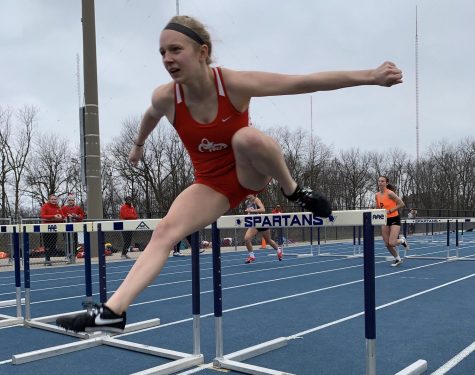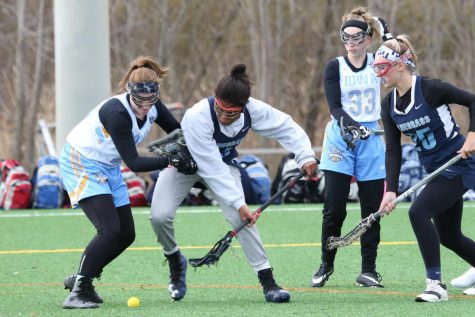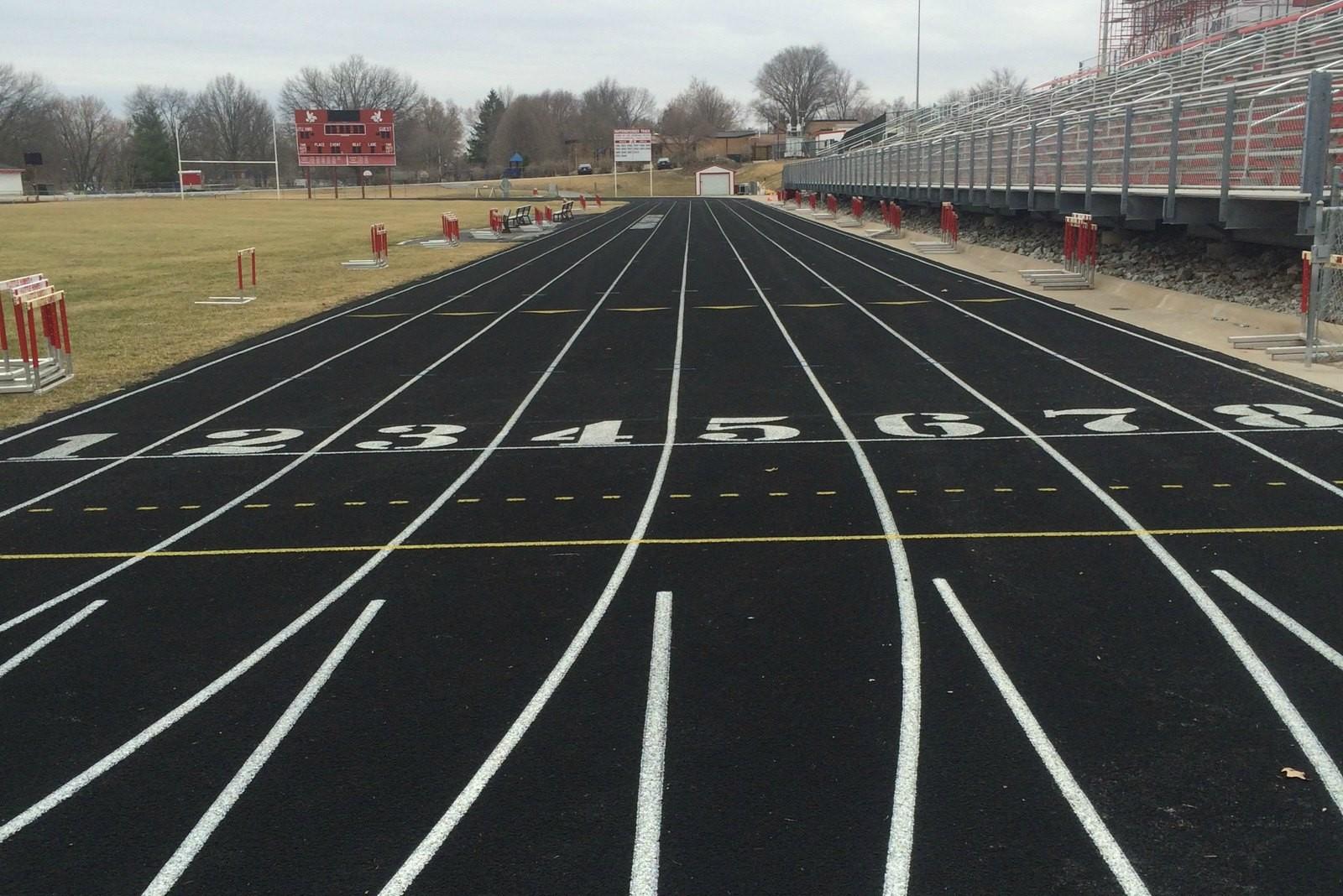Your donation will support the student journalists of Iowa City High School. For 2023, we are trying to update our video and photo studio, purchase new cameras and attend journalism conferences.
How COVID-19 is Affecting the College Recruitment Process
With uncertainty surrounding the spring sports season, both student athletes and college recruiters are dealing with how to move forward in a recruitment process taking place during the spread of COVID-19
March 19, 2020
Since the discovery of COVID-19 in December of 2019, the virus outbreak has been deemed both a pandemic by the World Health Organization and a national emergency by President Trump. COVID-19 has led to the use of extreme measures, including the lockdown of multiple countries.
With the closure of schools through April 13th in Iowa City and many parts of the US, and the postponement of spring athletics, the college recruitment process for spring athletes is feeling the effects of the virus.
“I would recommend that sophomores and juniors adjust the best they can right now. Do the best they can with online learning, find the part of sports that they enjoy and can replicate on their own, and to take care of themselves physically and mentally,” Lindsey Horner, Division I head women’s soccer coach at Drake University, said. “When we all get through this, there will be an adaption phase to playing again.”
It’s frustrating. I feel like I’ve put in all this work and now it’s just like there was no point to it because I don’t have anything to show [this season].
— Sekafetz
While the full extent of COVID-19’s effects on the recruitment process can’t be identified yet, some high school athletes are already starting to worry.
“It’s frustrating. I feel like I’ve put in all this work and now it’s just like there was no point to it because I don’t have anything to show [this season],” Jordan Sekafetz ‘21 said.
Sekafetz has participated in track and field for the past four years and hopes to continue her career in the sport on a Division I or II college team. Her main events are hurdling, sprinting, and long jump. She is currently ranked 24th in 60m hurdles for Iowa, according to Athletic.net.
“What’s hard about this year is that I haven’t had anything but indoor [track] season to really show college coaches what I have this season and how much I’ve improved between my last high school years,” Sekafetz said.
All activities of both the Iowa Girls High School Athletic Union and the Iowa High School Athletic Union are canceled during the four-week closure of Iowa schools as recommended by Iowa Governor Reynolds. This includes a ban of in-person contact between high school coaches and student athletes. According to the IGHSAU website, no decisions have been made about events following this four week period.

Jordan Sekafetz ’21 racing the 100 meter hurdles on April 5, 2019 during her sophomore track season.
In addition, the National Collegiate Athletic Association, the governing body for student athletes in multiple conferences throughout North America, has put in place a recruiting dead period, which includes “an immediate ban on in-person recruiting from Division I coaches” and the suspension of “any official and unofficial visits to campus from prospective student athletes.” This creates new challenges for coaches and recruiters from all Divisions.
“We are still in the early stages of trying to figure out how to push forward recruiting wise,” David Paulsen, the Division I head coach of both the cross-country and track and field teams at the University of Northern Iowa, said. “There’s a lot more questions than answers right now.”
Philip Hansen, the Athletic Direct of City High, recommends athletes continue practicing from the safety of their homes.
“This is an unprecedented time for athletes and recruiters,” Hansen said. “Spring seasons have not been canceled entirely yet, so athletes should be ready when the opportunity arises. Remember all athletes in Iowa and surrounding states are facing the same challenges.”
The Effects on Juniors
Junior year is when the NCAA allows high school athletes to start directly talking to college coaches about potential scholarships. Athletes often use their performance in their junior season to help them find recruiting opportunities.
“Next year’s senior class may be even more affected than this year’s senior class,” Paulsen said. “I think the juniors might see the biggest hit as far as recruiting opportunities, just for the lack of being able to show their performances improve.”
According to Paulsen, a high school athlete generally improves the most between their sophomore and junior year. He thinks this will make it harder for colleges to identify which spring sport athletes they want to recruit, and may reverse the trend towards early commitment.
“We might see a recruiting process next year like we have had in the past where we don’t do as many early signing because we are very uncertain on where the juniors are at,” Paulsen said.
Jason Wakenight, the Assistant Coach and Recruitment Coordinator of the Division 1 University of Iowa Track and Field Team, also described how the missing season may lead to more uncertainty in current juniors’ abilities.
“I think there’s gonna be a little bit more guesswork. It’s not going to be quite as informed and educated of a decision so we’re going to have to look at some intangibles when we decide to sign an athlete because the numbers aren’t gonna be there,” Wakenight said. “We’re just gonna have to use a lot of our experience and background from previous seasons to [decide] who we are going to go after and who we are going to sign.”
I think there’s a lot of kids out there, who were on their way to having a great junior season and actually achieving marks that would have gotten our attention and [now] they’re not going to have that opportunity.
— Wakenight
For Wakenight, these intangibles include height and body build, which normally factor into a recruiting decision, but will have a bigger impact due to the lack of other statistics. However, past performances at state meets will also remain an important factor, which may be a problem for some juniors.
“I think there’s a lot of kids out there, who were on their way to having a great junior season and actually achieving marks that would have gotten our attention and [now] they’re not going to have that opportunity,” Wakenight said.
Without the times from their junior season, colleges will have to rely on older times from their sophomore seasons until more recent times become available. According to Wakenight, this will make the recruitment process a little trickier but it will still be important for recruiting coaches to not rush with signing athletes, even if it means that they have to wait until later next year.
“We recruit hard every year. So we’re in a position where even if we’re not pulling the trigger and signing a ton of kids next season, I think we have to have the infrastructure in place to have a really, really good program and to move forward as a team,” Wakenight said. “We’re going to be patient. We’re going to take our time and evaluate these athletes. We want to make sure we’re not gonna go out there and make a mistake just because we’re in panic mode.”
This may mean fewer track and field athletes will end up coming to the University of Iowa for recruiting visits next fall, as the college may wait until April or May to sign some athletes from the 2021 class.

Kate Kueter ’21 (left) struggling against an opposing player to get the lacrosse ball as she plays for the Iowa Mavericks.
Other spring sport athletes affected include Kate Kueter ’21. She has played lacrosse since third grade and is now looking at Division II and III colleges to continue her playing career. Her main lacrosse season starts in the spring and continues through the summer.
“My season is basically canceled when it really hasn’t begun yet,” Kueter said. “It is really hard to think about it because you get so little time anyways for coaches and colleges to see you and what you can do. To just cut that time in half is devastating.”
Kueter has been looking at colleges that would be a good fit for her since sophomore year, but due to NCAA regulations, she was not able to directly communicate with the coaches about recruiting her.
“Lacrosse has just been such a big part of my life since such a young age that I can’t really imagine not having lacrosse in it. College would be that last chance I would get to be in lacrosse,” Kueter said.
The Effects on Seniors
However, COVID-19’s effects in the recruitment process are not limited to high school juniors. If the championship track meets get canceled, recruiters will have a harder time evaluating the athletic performance of all athletes.
“I think the opportunities to show yourself are going to be very limited,” Paulsen said. “That is definitely a big problem. We have a lot of kids that come on late in their high school careers that maybe weren’t on the radar because they didn’t have the best times as juniors but they have really good senior years. So [now] the opportunity is not there for them to perform and allow coaches to see the improvements they have made. Those kids will probably end up not being looked at as much or maybe not at all.”
The University of Northern Iowa generally recruits five or six 12th-grade athletes between both the men and women’s track and field teams at the end of the high school track season, near the state meet. This means its roster is not yet finalized.
“We are always looking for a couple more [athletes] about this time of year, so we are just going to comb through where we thought people were going to be up and coming this year, and [possibly] just take a risk on someone without actually seeing their senior season,” Paulsen said.
Without the opportunity for coaches to watch athletes perform live, video footage of past games or races becomes more important. However, even with this footage, the ability of coaches to assess athletes is limited.
“Everything related to recruiting this spring will get delayed. All programs and student athletes are navigating this new timeline together,” Horner said. “Coaches can’t do much right now as it relates to evaluating prospective athletes. We have time to watch footage that a recruit might share with us at the moment, but the timeline of further evaluating players is on hold.”
If competition at a youth level were to resume this summer, Horner expects a lot of the recruiting to take place then.
“This recruiting cycle is very different,” Horner said. “I would hope coaches and recruits don’t make hurried decisions. Ultimately we want prospective student athletes to find the right fit and that takes time. If we start recruiting in a panicked state, then we aren’t making decisions that are best for our program or our players. While none of us have ever been in this situation, I imagine there will be changes to our normal recruiting procedures.”
Horner recommends high school athletes take this time to research colleges and athletic programs they may be interested in and communicate with their coaches.
“Our world is fighting to save human lives, and this disruption in routine will undoubtedly impact everything, recruiting included,” Horner said. “When we get the green light to play organized sports again, there will be a new normal.”
Our world is fighting to save human lives, and this disruption in routine will undoubtedly impact everything, recruiting included.
— Horner
Rick Hartzell is the Vice President for Athletics at the Upper Iowa University, a Division II school in northern Iowa. He thinks that for the recruitment process for the Upper Iowa University will not be very different compared to past years.
“Coaches will have to recruit students based on last year or last summer’s performance and they will most likely have to do it virtually and not in person,” Hartzell said. “It won’t be easy and some recruits will be left out, there is no doubt about that. Not seeing students in person makes the whole matter harder.”
The Upper Iowa University uses in-person evaluations, recommendations from coaches, and videos of past performances to analyze athletes for recruitment decisions. As a Division II school, it has a more limited number of scholarships to divide up between the four years of athletes.
“If [college] seniors come back and you recruit a strong [college] freshman class from the current high school seniors, then there will be a backlog and less interest or scholarships available for current underclass high school students now,” Hartzell said.
Students may be more interested in looking at teams where they are able to get more playing time.
“[Current sophomores and juniors] will have the same opportunities to be recruited,” Hartzell said. “That does not change. The best ones will get scholarships, but I do think the partial scholarships for less talented [athletes] will be fewer.”
For Division III schools, which do not have any scholarships to distribute, COVID-19 is causing other worries. The Division III head cross-country and track and field coach at Grinnell, Evelyn Freeman, is primarily concerned about current seniors’ decisions to enroll at Grinnell, since the campus visit scheduled for April was canceled.
“That’s a big disadvantage because the visit is, in my opinion, the thing that seals the deal,” Freeman said. “You can talk to people on the phone, you can look through all the media guides and the letters, but there’s nothing like getting on campus and getting a real feel for the place.”
This visit normally includes the student athletes visiting campus and staying overnight with a member of the sports team they are considering joining. It gives them the chance to get a feel for the community and questions.
Be[ing] patient is the first step. We are in uncharted waters.
— Moore
“They meet the team, get to ask the important questions. They get to sit in classes, eat in the dining hall, and just kind of hang out and get a real feel for the place,” Freeman said. “That’s going to be an important part of the recruiting process and the search process for the incoming students that’s going to be lacking this year. It’s just gonna make it harder for the seniors to make a decision.”
From college recruiters to current athletes, the ripple effects of COVID-19 are being felt in high school sports. The cancellation of current high school sports seasons is a challenge to the current college recruitment system, especially for athletes who hope for scholarships to continue their athletic careers.
“Be[ing] patient is the first step,” Mike Moore, the head coach for the boys track and field team at City High, said. “We are in uncharted waters. This year’s recruiting process is going to be a new challenge for the college coaches, athletes and high school coaches.”

